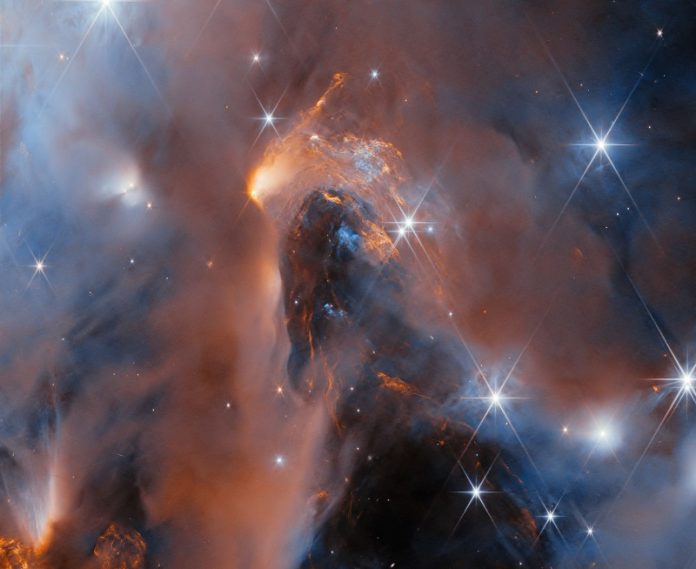
Rogue Planets, or free-floating planetary-mass objects (FFPMOs), are planet-sized objects that either formed in interstellar space or were part of a planetary system before gravitational perturbations kicked them out.
Since they were first observed in 2000, astronomers have detected hundreds of candidates that are untethered to any particular star and float through the interstellar medium (ISM) of our galaxy.
In fact, some scientists estimate that there could be as many as 2 trillion rogue planets (or more!) wandering through the Milky Way alone.
In recent news, a team of astronomers working with the James Webb Space Telescope (JWST) announced the discovery of six rogue planet candidates in an unlikely spot.
The planets, which include the lightest rogue planet ever identified (with a debris disk around it), were spotted during Webb‘s deepest survey of the young nebula NGC 1333, a star-forming cluster about a thousand light-years away in the Perseus constellation.
These planets could teach astronomers a great deal about the formation process of stars and planets.
The team was led by Adam Langeveld, an Assistant Research Scientist in the Department of Physics and Astronomy at Johns Hopkins University (JHU).
He was joined by colleagues from the Carl Sagan Institute, the Instituto de Astrofísica e Ciências do Espaço, the Trottier Institute for Research on Exoplanets, the Mont Mégantic Observatory, the Herzberg Astronomy and Astrophysics Research Centre, the University of Texas at Austin, the University of Victoria, the Scottish Universities Physics Alliance (SUPA) at the University of St Andrews.
The paper detailing the survey’s findings has been accepted for publication in The Astronomical Journal.
Most of the rogue planets detected to date were discovered using Gravitational Microlensing, while others were detected via Direct Imaging.
The former method relies on “lensing events,” where the gravitational force of massive objects alters the curvature of spacetime around them and amplifies light from more distant objects.
The latter consists of spotting brown dwarfs (objects that straddle the line between planets and stars) and massive planets directly by detecting the infrared radiation produced within their atmospheres.
In their paper, the team describes how the discovery occurred during an extremely deep spectroscopic survey of NGC1333. Using data from Webb‘s Near-Infrared Imager and Slitless Spectrograph (NIRISS), the team measured the spectrum of every object in the observed portion of the star cluster.
This allowed them to reanalyze spectra from 19 previously observed brown dwarfs and led to the discovery of a new brown dwarf with a planetary-mass companion. This latter observation was a rare find that already challenges theories of how binary systems form.
But the real kicker was the detection of six planets with 5-10 times the mass of Jupiter (aka. super-Jupiters).
This means these six candidates are among the lowest-mass rogue planets ever found that formed through the same process as brown dwarfs and stars.
This was the purpose of the Deep Spectroscopic Survey for Young Brown Dwarfs and Free-Floating Planets survey, which was to investigate massive objects that are not quite large enough to become stars.
The fact that Webb’s observations revealed no objects lower than five Jupiter masses (which it is sensitive enough to detect) is a strong indication that stellar objects lighter than are more likely to form the way planets do.
Said lead author Langeveld in a statement released by JHU’s new source (the Hub):
“We are probing the very limits of the star-forming process. If you have an object that looks like a young Jupiter, is it possible that it could have become a star under the right conditions? This is important context for understanding both star and planet formation.”
The most intriguing of the rogue planets was also the lightest: an estimated five Jupiter masses (about 1,600 Earths).
Since dust and gas generally fall into a disk during the early stages of star formation, the presence of this debris ring around the one planet strongly suggests that it formed in the same way stars do.
However, planetary systems also form from debris disks (aka. circumsolar disks), which suggests that these objects may be able to form their own satellites. This suggests that these massive planets could be a nursery for a miniature planet system – like our Solar System, but on a much smaller scale.
Said Johns Hopkins Provost Ray Jayawardhana, an astrophysicist and senior author of the study (who also leads the survey group):
“It turns out the smallest free-floating objects that form like stars overlap in mass with giant exoplanets circling nearby stars. It’s likely that such a pair formed the way binary star systems do, from a cloud fragmenting as it contracted. The diversity of systems that nature has produced is remarkable and pushes us to refine our models of star and planet formation…
“Our observations confirm that nature produces planetary mass objects in at least two different ways—from the contraction of a cloud of gas and dust, the way stars form, and in disks of gas and dust around young stars, as Jupiter in our own solar system did.”
In the coming months, the team plans to use Webb to conduct follow-up studies of these rogue planets’ atmospheres and compare them to those of brown dwarfs and gas giants. They also plan to search the star-forming region for other objects with debris disks to investigate the possibility of mini-planetary systems.
The data they obtain will also help astronomers refine their estimates on the number of rogue planets in our galaxy. The new Webb observations indicate that such bodies account for about 10% of celestial bodies in the targeted cluster.
Current estimates place the number of stars in our galaxy between 100 and 400 billion stars and the number of planets between 800 billion and 3.2 trillion. At 10%, that would suggest that there are anywhere from 90 to 360 billion rogue worlds floating out there.
As we have explored in previous articles, we might be able to explore some of them someday, and our Sun may even capture a few!
Written by Matt Williams/Universe Today.



